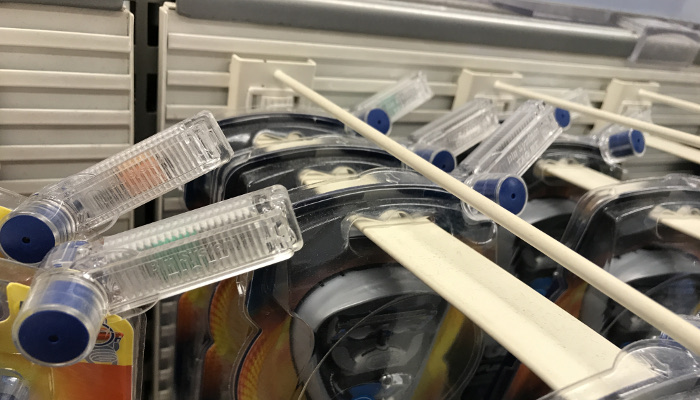College Releases Research into Retail Tagging
This has been provided by the college of policing. You can read more about the impact of electronic tags on retail theft by visiting the Retail tagging page of the WhatWorks: Crime Reduction Systematic Review Series.
The retail tagging part of the Crime reduction toolkit is also available at http://whatworks.college.police.uk/toolkit/Pages/Intervention.aspx?InterventionID=45
What is retail tagging?


Tags are a type of security measure commonly used by retailers to prevent the theft of products and packaged goods. They can take various forms, including bottle caps, spider-wraps and anti-tamper seals. In our review we focused on two types of t
Tags are a type of security measure commonly used by retailers to prevent the theft of products and packaged goods. They can take various forms, including bottle caps, spider-wraps and anti-tamper seals. In our review we focused on two types of tag:
1. Ink tags - which are usually made of plastic and contain a vial of indelible ink. If an ink tag is forcibly detached then the ink vial breaks and the product is tarnished
2. Electronic article surveillance or EAS tags. These can also take different forms, from large plastic tags to small magnetic strips. As the name suggests, EAS tags are electronic and omit a signal to a corresponding detector gate. If an EAS tag is not removed or deactivated at point of sale, then on passing detector gates the alarm should sound thereby indicating that a theft may be in progress.
What did the systematic review tell us about the impact of retail tagging on reducing crime?
Across the eight evaluation studies identified, five showed decreases in theft or shrinkage following the installation of tags; shrinkage being the popular catch all term referring to retail losses attributed to theft as well as error, damage or wastage. Though definitions of shrinkage vary by retailer, it often denotes the difference between expected and actual levels of stock. Moreover, the evidence suggests that highly visible, conspicuous tags tend to perform better than less-visible, inconspicuous tags. We were unable to compute a single overall effect size of the effectiveness of tagging as a theft prevention measure. This is because the available evaluation studies related to very different tagging strategies – conspicuous vs inconspicuous tags, tags attached to all products or just some products – and often used different outcome measures (such as theft or shrinkage).
The What works Centre Centre was supported by a Commissioned partnership programme which was jointly funded by the College and the Economic and Social Research Council. This Consortium undertook a programme of new crime reduction systematic reviews including the one into retail tagging. As more research becomes available further reviews may be commissioned to revisit this area of crime prevention work as well as new topics.
If you are considering research in this area or others please visit the research map first to see what is currently going on or add your work to it!
https://nbcc.police.uk/article/?id=a8945899c6177e360671c6f67ab58de9
For further information or to receive our regular College What Works updates, please email whatworks@college.pnn.police.uk
ag:
1. Ink tags - which are usually made of plastic and contain a vial of indelible ink. If an ink tag is forcibly detached then the ink vial breaks and the product is tarnished
2. Electronic article surveillance or EAS tags. These can also take different forms, from large plastic tags to small magnetic strips. As the name suggests, EAS tags are electronic and omit a signal to a corresponding detector gate. If an EAS tag is not removed or deactivated at point of sale, then on passing detector gates the alarm should sound thereby indicating that a theft may be in progress.
What did the systematic review tell us about the impact of retail tagging on reducing crime?
Across the eight evaluation studies identified, five showed decreases in theft or shrinkage following the installation of tags; shrinkage being the popular catch all term referring to retail losses attributed to theft as well as error, damage or wastage. Though definitions of shrinkage vary by retailer, it often denotes the difference between expected and actual levels of stock. Moreover, the evidence suggests that highly visible, conspicuous tags tend to perform better than less-visible, inconspicuous tags. We were unable to compute a single overall effect size of the effectiveness of tagging as a theft prevention measure. This is because the available evaluation studies related to very different tagging strategies – conspicuous vs inconspicuous tags, tags attached to all products or just some products – and often used different outcome measures (such as theft or shrinkage).
The What works Centre Centre was supported by a Commissioned partnership programme which was jointly funded by the College and the Economic and Social Research Council. This Consortium undertook a programme of new crime reduction systematic reviews including the one into retail tagging. As more research becomes available further reviews may be commissioned to revisit this area of crime prevention work as well as new topics.
If you are considering research in this area or others please visit the research map first to see what is currently going on or add your work to it!
https://nbcc.police.uk/article/?id=a8945899c6177e360671c6f67ab58de9
For further information or to receive our regular College What Works updates, please email whatworks@college.pnn.police.uk
